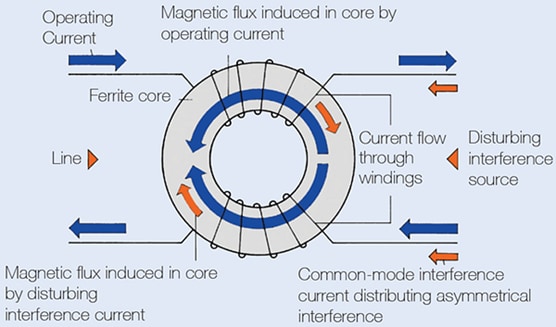
EPCOS / TDK High Current Ring Core Chokes
Electrical and electronic equipment generates common-mode interference. In order to meet the safety requirements within the leakage current limits, chokes with a high asymmetrically effective inductance must be used. EPCOS common-mode chokes with a closed core topology are especially suitable for this purpose.
Product Lineup

Features
- Glueless design for most parts
- Voltages up to 1000V
- Insulation system Class 155 (F) to UL 1446 applicable (most parts)
- Open design for improved thermal performance and cooling
- B8272*V2*U* suitable for household appliances (white goods) in accordance with EN 60335-2-x standards
Applications
- Consumer
- Refrigerators (compressor)
- Air-conditioners (compressor and fan motor)
- Dishwashers (water pump)
- Vacuum cleaners (motor drive)
- Industrial
- Cooling fans and compressors
- Circulation pumps for cooling and heating systems
- General motor drives such as conveyor belts, elevator, and sliding doors
Application Diagram

Double Chokes
B8272*E6 - 600VAC / 1000VDC, 0.42mH to 3.3mH, 20A to 50A, +70°C - Datasheet
B8272*V2*U* - 250VAC, 1mH to 6.25mH, 10A to 17A, +70°C - Datasheet
B82726S2163 - 250VAC, 1.4mH, 2.2mH, 16A, +60°C - Datasheet
B82726S2183 - 250VAC, 1.3mH, 18A, +50°C - Datasheet
B82726S22*3 - 250VAC, 0.75mH, 1.6mH, 20A, 24A, +60°C - Datasheet
B82725S2* - 250VAC, 1.4mH to 7.8mH, 6A to 13A, +60 °C, +70°C - Datasheet
B82726S3223A340 - 300VAC / 550VDC, 1.7mH, 25A, +70°C - Datasheet
B82726S3543 - 300VAC / 700VDC, 0.19mH, 54A, +75°C - Datasheet
B82726S61*3 - 250VAC / 750VDC, 2.2mH, 3.3mH, 10A, 12A, +85°C - Datasheet
Triple Chokes
B82747E6 - 600VAC / 350VAC, 0.57mH to 2.2mH, 16A to 35A, +70°C - Datasheet
B82747S6313 - 440VAC / 250VAC, 0.95mH, 31A, +70°C - Datasheet
B82745S6123 - 440VAC / 250VAC, 0.35mH, 12A, +85°C - Datasheet
B82747S4 - 500VAC / 300VAC, 0.82mH, 0.85mH, 30A, 35A, +70°C - Datasheet
B82746S - 550VAC / 320VAC, 3.2mH, 6.2mH, 8A, 13A, +70°C - Datasheet
B82746S4 - 500VAC / 300VAC, 0.75, 1.15mH, 20A, +70°C - Datasheet
B82747S4183 - 440VAC / 250VAC, 1.8mH, 18A, +70°C - Datasheet
B82748S6623 - 690VAC / 400VAC, 1.1mH, 62A, +40°C - Datasheet
B82746S4103A02* - 500VAC / 300VAC, 520VAC / 300VAC, 1.7mH, 2mH, 10A, +70°C - Datasheet
B82747S4203A - 520VAC / 300VAC, 1.3mH, 20A, +60°C - Datasheet
B82747S4423 - 440VAC / 250VAC, 1.5mH, 42A, +50°C - Datasheet
Magnetic Flux

FAQ
Why are common-mode chokes necessary?
Common mode chokes are used in EMI filtering circuits to help achieve electromagnetic compatibility (EMC). The chokes accomplish this by suppressing conducted noise, which is common in all types of power transmission and power lines.
There is often no marking to indicate the winding direction (polarity) on common mode chokes. Is operation impacted if the winding on the chokes is not aligned when mounted?
The mounting direction does not impact the operating characteristics of common-mode chokes.
Do common mode chokes create heat?
The chokes generate heat, but it is in proportion to the power. The amount of power flowing is calculated using the standard I2 x R equation, where R is the DC resistance of the common mode choke for a DC current, or the RMS value of an AC current. The EMI chokes are designed to suppress high-frequency noise, and there is no significant loss introduced by this noise into the core or windings that might contribute to the heat generated.
Can a common mode choke withstand more than its rated current, if applied for a short period of time?
Although it depends on the magnitude of the current and length of time during which the current is applied, EPCOS / TDK products are not covered under warranty when used with a current that is higher than the rated current at a specific ambient temperature.
What is the difference between differential mode and common mode?
Differential (normal) mode refers to signals or noise flowing in opposite directions in a pair of lines. Common mode refers to signals or noise flowing in the same direction in all lines. The choke graphic (below) shows two copper wires are wound on a ferrite ring core. In this structure, two patterns can exist: one with currents flowing in the same direction (common mode), and another with currents flowing in opposite directions (differential mode).
Common Vs. Differential Mode




